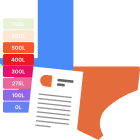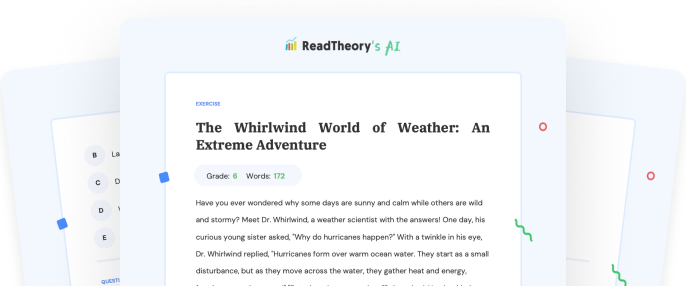Transform Your Teaching
with AI-Powered Worksheets
With ReadTheory’s Instant Worksheet Builder, you can create engaging, grade-appropriate worksheets tailored to your students in minutes. Spark curiosity, save time, and empower critical thinking with AI-powered tools designed for teachers like you.


The Science and Impact of Natural Disasters
Natural disasters are powerful and unexpected events that can change our lives in an instant. They are caused by changes in the Earth's environment, such as shifts in tectonic plates leading to earthquakes, or warm ocean water fueling hurricanes. While awe-inspiring, natural disasters can cause severe damage to communities. Buildings may be destroyed, roads washed away, and sadly, lives may be lost. Despite the challenges, communities come together to heal and rebuild, showing remarkable resilience in the face of adversity. There are many types of natural disasters. Earthquakes shake the ground beneath our feet, hurricanes bring strong winds and heavy rain, floods submerge streets and homes, and wildfires can burn vast areas of land.
Question 1
What causes earthquakes?
Warm ocean water
Shifts in tectonic plates
Heavy rain
Strong winds
Wildfires
Question 2
What is the impact of natural disasters on communities?
Communities become stronger
Communities are destroyed
No impact
Communities become wealthier
Communities become less populated
Question 3
What fuels hurricanes?
Heavy rain
Warm ocean water
Strong winds
Shifts in tectonic plates
Wildfires
Question 4
What does the term 'resilience' mean in the context of natural disasters?
The ability to predict disasters
The ability to avoid disasters
The ability to cause disasters
The ability to recover quickly from disasters
The ability to watch disasters
Question 5
What is not a type of natural disaster mentioned in the text?
Floods
Wildfires
Earthquakes
Hurricanes
Volcanic eruptions
 or share via
or share via

Assign the ReadTheory pretest to determine students' reading levels.

Why Teachers Love
Instant Worksheet Builder?

Tailored Content for Every Student
Craft worksheets with passages and multiple-choice questions customized to your chosen topic and grade level, ensuring relevance and engagement.

Save Hours
of Prep Time
Our AI, Lexi, generates complete worksheets—passages, questions, and answers—in minutes, freeing you to focus on teaching, not planning.

Standards-Aligned Learning
Every worksheet is designed to boost reading comprehension and critical thinking, aligning seamlessly with State Standards to help your students shine.
Personalized teaching
for personalized learning
Browse worksheets created and refined by educators using Lexi—your source for inspiration and ready-to-use resources.


ReadTheory is free for Teachers to use.
Join thousands of educators using ReadTheory for free. Sign up today and start creating in just minutes!





